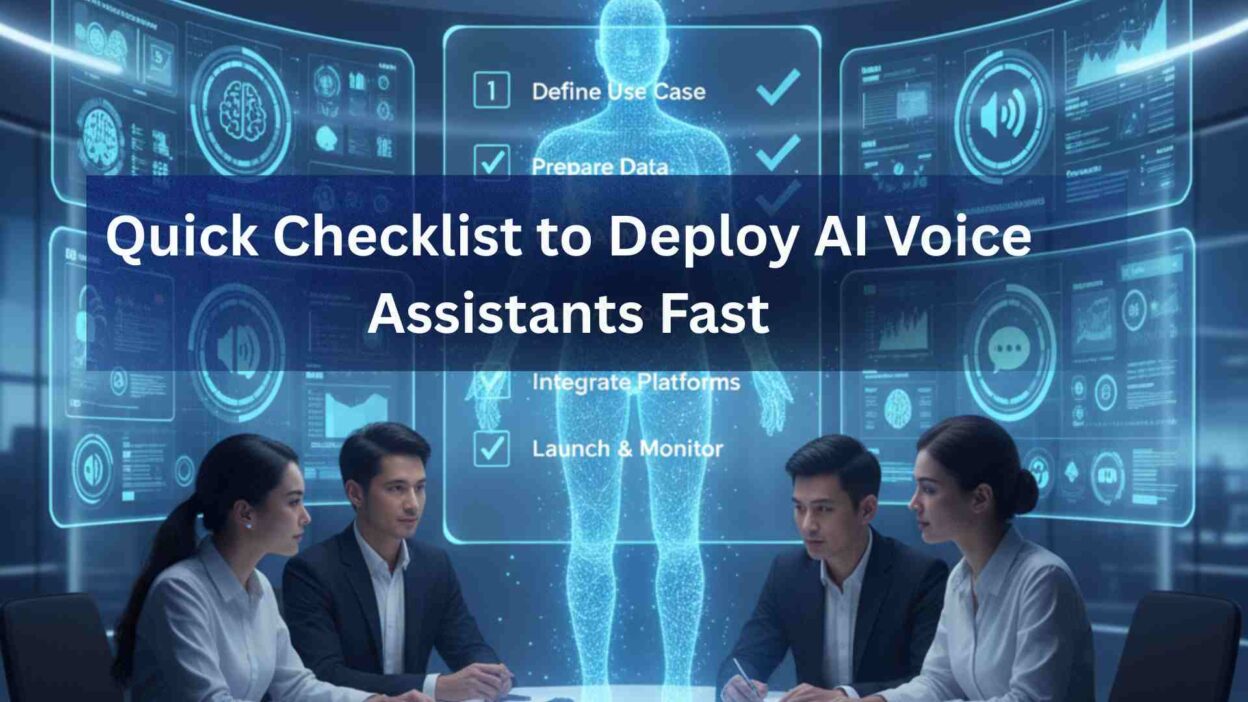Introduction
TL;DR Healthcare has changed dramatically in recent years. Telehealth became essential during the pandemic. Now it’s a permanent fixture in medical care delivery.
Table of Contents
Patient calls flooded healthcare systems overnight. Staff struggled to keep up with demand. Traditional phone systems couldn’t handle the volume.
AI voice assistants emerged as the solution. These smart systems manage calls efficiently. They free up human staff for complex tasks.
Deploying these systems seems daunting at first. Many healthcare providers hesitate to start. They worry about complexity and cost.
This guide simplifies the entire process. You’ll learn exactly what steps to take. AI solutions for managing telehealth patient calls can be deployed faster than you think.
The benefits are immediate and measurable. Patient satisfaction improves within weeks. Staff burnout decreases significantly.
Let’s explore how to make this transformation happen.
Understanding AI Voice Assistants in Healthcare
What Are AI Voice Assistants?
AI voice assistants are sophisticated software programs. They understand and respond to human speech. These systems use natural language processing technology.
Think of them as digital receptionists. They never take breaks or sick days. They handle multiple calls simultaneously.
The technology has matured significantly recently. Modern systems understand medical terminology accurately. They can handle complex patient inquiries.
These assistants integrate with existing systems seamlessly. Your electronic health records connect directly. Scheduling software works in harmony.
Why Telehealth Needs AI Voice Solutions
Telehealth exploded in popularity recently. Patient call volumes increased by 300% in some practices. Human staff couldn’t scale quickly enough.
Patients expect immediate responses now. Waiting on hold frustrates them immensely. Many abandon calls after just minutes.
AI solutions for managing telehealth patient calls solve this problem directly. They answer immediately every single time. No patient ever waits on hold.
The consistency matters tremendously in healthcare. Every patient receives the same quality service. Human error gets eliminated from routine tasks.
After-hours coverage becomes simple to implement. The AI never sleeps or needs rest. Emergency calls get handled 24/7.
Key Benefits for Healthcare Providers
Cost savings appear within the first month. One AI assistant replaces multiple full-time positions. The ROI becomes positive quickly.
Staff morale improves dramatically with AI support. Nurses and receptionists focus on meaningful work. Repetitive questions get handled automatically.
Patient outcomes improve measurably with better access. Appointment adherence increases when scheduling is easy. Follow-up reminders reduce no-show rates.
Compliance becomes easier to maintain consistently. Every conversation gets recorded and documented. HIPAA requirements are built into the system.
Data insights emerge from every interaction. You’ll understand patients needs better. Common questions reveal areas needing attention.
Pre-Deployment Planning Checklist
Assess Your Current Call Management System
Start by analyzing your existing setup thoroughly. How many calls does your practice receive daily? What percentage are routine scheduling requests?
Track call abandonment rates for one week. Note peak calling times carefully. Identify which questions staff answer repeatedly.
Document the current staff time spent on phones. Calculate the actual cost per call handled. These baseline metrics prove ROI later.
Survey your team about their biggest challenges. They know pain points better than anyone. Their input shapes your AI requirements.
Review patient complaints related to phone access. Long wait times appear frequently. These issues disappear with AI implementation.
Define Your Specific Use Cases
AI solutions for managing telehealth patient calls can handle numerous tasks. Prioritize which functions matter most initially. Start with high-volume, low-complexity interactions.
Appointment scheduling is the obvious first choice. Prescription refill requests work perfectly, too. General information queries are ideal candidates.
Insurance verification can be automated easily. Symptom pre-screening saves triage nurse time. Post-appointment follow-ups improve patient care.
Consider your practice’s unique needs carefully. Specialty practices have specific requirements. Pediatrics differs greatly from geriatric care.
Create a prioritized list of features needed. Rank them by impact and urgency. This list guides vendor selection later.
Set Clear Goals and Success Metrics
Define what success looks like specifically. Reduce call wait times to under 30 seconds? Decrease staff phone time by 60%?
Set patient satisfaction targets clearly. Aim for specific Net Promoter Score improvements. Track these metrics from day one.
Establish cost reduction goals with precise numbers. Calculate expected savings in staff hours. Project decreased overtime expenses.
Determine patient access improvement targets explicitly. Measure after-hours call handling capacity. Track appointment scheduling conversion rates.
Document these goals in writing formally. Share them with your entire team. Review progress weekly during initial deployment.
Budget and Resource Allocation
AI voice assistant costs vary significantly. Monthly subscription models are most common. Expect $500 to $5000 monthly, depending on volume.
Setup fees range from zero to several thousand dollars. Some vendors waive these with annual commitments. Compare the total cost of ownership carefully.
Factor in staff training time realistically. Plan for 10-20 hours of initial setup. Ongoing management requires minimal time weekly.
Consider integration costs with existing systems. Some connections are free and automatic. Complex custom integrations cost more.
Budget for contingency and unexpected expenses. Add 20% buffer to your estimates. AI solutions for managing telehealth patient calls deliver ROI regardless.
Choosing the Right AI Voice Assistant Platform
Essential Features for Telehealth
Natural language understanding is absolutely critical. The system must comprehend medical terminology. Patient accents and speech patterns vary widely.
HIPAA compliance is non-negotiable in healthcare. The platform must meet all security requirements. Data encryption should be military-grade.
Multi-language support expands your patient reach. Spanish and other languages are essential. The AI should switch languages seamlessly.
Integration capabilities determine long-term success. Your EHR system must connect easily. Scheduling software integration is mandatory.
Customization allows you to match your practice personality. The AI should sound like your brand. Scripts need easy modification abilities.
Evaluating Vendor Options
Research at least five different vendors thoroughly. Read reviews from healthcare providers specifically. General business reviews don’t apply here.
Request detailed demonstrations from each vendor. Bring your staff to these presentations. Their practical perspective reveals important details.
Ask about implementation timelines specifically. Some vendors deploy in days. Others take months to go live.
Investigate customer support quality carefully. Healthcare operates outside business hours. You need 24/7 technical support availability.
Review contract terms with legal counsel. Understand termination clauses completely. Avoid vendors requiring multi-year commitments initially.
Security and Compliance Considerations
HIPAA compliance documentation must be thorough. Request Business Associate Agreements immediately. Review their security audit history.
Data storage location matters significantly legally. US-based servers are often required. Understand exactly where patient data lives.
Encryption standards should exceed minimum requirements. Both data at rest and in transit. Ask about their security protocols specifically.
Access controls need proper implementation. Role-based permissions protect patient information. Audit trails must track every access.
Disaster recovery plans should be documented clearly. How quickly can service be restored? What backup systems exist?
Integration Capabilities
Your EHR system integration is paramount. The AI needs real-time data access. Scheduling changes must sync immediately.
Calendar systems require bidirectional synchronization. The AI books appointments automatically. Changes appear instantly in your schedule.
Payment processing integration streamlines collections. Patients can pay over the phone securely. Outstanding balances get addressed proactively.
SMS and email systems need a connection. Appointment confirmations are sent automatically. Reminders reduce no-show rates dramatically.
Analytics platforms should receive data automatically. Dashboard visibility helps track performance. Real-time reporting enables quick adjustments.
Step-by-Step Deployment Process
Phase 1: System Configuration (Week 1-2)
Begin with the basic system setup immediately. Upload your practice information completely. Enter all providers and their schedules.
Configure your call flow logic carefully. Map out every possible patient pathway. Simple flows work better initially.
Record or generate greeting messages professionally. Your AI voice represents your practice. Quality matters tremendously here.
Input frequently asked questions with answers. Start with your top 20 questions. Add more based on actual call data.
Set up integration connections to other systems. Test each connection thoroughly. Verify data flows correctly both ways.
Phase 2: Script Development and Training
Write conversational scripts that sound natural. Avoid robotic or overly formal language. AI solutions for managing telehealth patient calls should feel human.
Include empathy and warmth in responses. Patients are often anxious or unwell. Compassionate language makes a huge difference.
Build decision trees for complex scenarios. Account for various patient responses. Plan for unexpected answers appropriately.
Train the AI with your specific terminology. Medical practices have unique vocabularies. Specialty terms need explicit teaching.
Test scripts extensively with diverse voices. Include various accents and speech patterns. Refine based on comprehension accuracy.
Phase 3: Testing and Quality Assurance
Conduct internal testing with staff first. Have team members call repeatedly. Try to break the system intentionally.
Run through every possible call scenario. Test appointment scheduling thoroughly. Verify information retrieval works correctly.
Check integration points multiple times. Ensure data syncs properly everywhere. Look for any delays or errors.
Record test calls for detailed review. Listen for awkward phrasing or confusion. Smooth out rough spots immediately.
Involve a small group of patients in beta testing. Their feedback proves invaluable. Real-world usage reveals unexpected issues.
Phase 4: Staff Training and Onboarding
Train your team on the new system completely. Everyone needs to understand how it works. Resistance decreases with proper education.
Demonstrate how AI helps rather than replaces staff. Show how it handles mundane tasks. Emphasize their elevated role in patient care.
Teach staff how to monitor AI performance. They should review conversations periodically. Feedback helps improve system accuracy.
Create clear escalation procedures for complex situations. Staff should know when AI transfers calls. Seamless handoffs maintain patient satisfaction.
Develop simple documentation for quick reference. One-page guides work best. Update these based on common questions.
Phase 5: Soft Launch and Monitoring
Start with limited hours initially. Run AI during less busy times first. Monitor closely for any issues.
Keep human backup available constantly. Staff can intervene if problems arise. This safety net reduces anxiety.
Track all key metrics from day one. Compare against baseline measurements. Look for both improvements and problems.
Gather patient feedback actively and regularly. Short post-call surveys work well. Their input drives refinements.
Meet daily during the first week. Discuss observations and concerns openly. Make adjustments quickly based on learnings.
Phase 6: Full Deployment and Optimization
Expand AI coverage hours gradually. Add more complex call types progressively. Build confidence before full deployment.
AI solutions for managing telehealth patient calls improve with use. The system learns from every interaction. Accuracy increases over time automatically.
Continue monitoring key performance indicators closely. Watch for any degradation in metrics. Address issues before they become problems.
Gather ongoing feedback from staff regularly. They notice subtle issues first. Their observations guide continuous improvement.
Optimize scripts based on real call data. Identify common confusion points. Refine language for better comprehension.
Common Challenges and Solutions
Handling Patient Resistance
Some patients prefer speaking with humans initially. This reaction is completely normal. Most adapt within weeks.
Offer an immediate transfer option clearly. Patients appreciate knowing humans are available. This reduces anxiety significantly.
Explain the benefits directly to concerned patients. Faster service benefits them immediately. No hold times matter tremendously.
Train AI to detect frustration early. Automatic escalation to humans prevents problems. Smooth transitions maintain satisfaction.
Share success stories and positive feedback. Other patients’ experiences reassure skeptics. Social proof works effectively here.
Technical Integration Issues
EHR integration can be complex initially. Work closely with vendors on both sides. Expect some trial and error.
API connections sometimes fail intermittently. Build monitoring systems to catch issues. Automatic alerts enable quick responses.
Data synchronization delays cause occasional problems. Buffer times prevent double-booking appointments. Plan for small time gaps.
Legacy systems may lack proper APIs. Custom middleware solutions might be necessary. Budget extra for older technology.
AI solutions for managing telehealth patient calls continue improving. Regular updates add new integration capabilities. Stay current with system versions.
Maintaining HIPAA Compliance
Regular security audits are essential. Schedule quarterly reviews minimum. Document everything meticulously.
Staff training on privacy must continue. Annual refreshers keep compliance top of mind. New regulations require updates.
Monitor access logs systematically. Unusual patterns need immediate investigation. Proactive monitoring prevents breaches.
Update Business Associate Agreements regularly. Regulatory changes require contract modifications. Legal review ensures ongoing compliance.
Incident response plans need regular testing. Practice breach scenarios quarterly. Quick response minimizes potential damage.
Dealing with Accents and Speech Variations
AI systems struggle with some accents initially. Training with diverse voice samples helps. Performance improves with exposure.
Offer alternative input methods when needed. Touch-tone navigation provides backup. SMS-based scheduling works wonderfully.
Regional dialects require specific training. Collect sample calls from your patient population. Feed these to the system regularly.
Background noise sometimes interferes with recognition. Advanced noise cancellation helps significantly. Some environments remain challenging.
Continuous learning algorithms adapt automatically. The system gets better over time. Patient diversity actually improves performance.
Measuring Success and ROI
Key Performance Indicators to Track
Call answer rates should approach 100%. Abandonment rates should drop to nearly zero. These improvements happen immediately.
Average handling time measures efficiency gains. Compare AI times to human benchmarks. Most calls were completed 40% faster.
Patient satisfaction scores indicate quality levels. Track NPS before and after deployment. Most practices see significant increases.
Staff productivity metrics reveal time savings. Measure tasks completed per staff hour. Administrative burden decreases measurably.
Cost per call drops substantially with AI. Calculate fully loaded costs, including benefits. Savings often exceed 60%.
Calculating Return on Investment
List all implementation costs completely. Include setup fees and monthly subscriptions. Don’t forget training time costs.
Calculate staff time savings in dollars. Multiply hours saved by loaded labor rates. This typically shows the largest ROI.
Factor in reduced overtime expenses. Many practices eliminate overtime. Weekend and evening coverage becomes free.
Include improved patient retention benefits. Better access keeps patients from leaving. Lifetime patient value is substantial.
AI solutions for managing telehealth patient calls pay for themselves quickly. Most practices break even within 3-6 months. Annual savings can be enormous.
Patient Satisfaction Improvements
Survey patients about their experience specifically. Ask about wait times and ease of scheduling. Compare before and after scores.
Monitor online reviews for sentiment changes. Improved access generates positive feedback. Respond to all reviews graciously.
Track appointment no-show rates carefully. Better reminders improve attendance. Each kept appointment increases revenue.
Measure after-hours access satisfaction separately. Patients love 24/7 availability. This differentiator attracts new patients.
Net Promoter Scores typically increase 20-30 points. Patients become advocates for your practice. Referrals increase organically.
Staff Satisfaction and Productivity
Survey staff about job satisfaction regularly. Reduced phone burden improves morale. They can focus on clinical care.
Track turnover rates before and after. Better work environments retain staff. Recruitment costs decrease substantially.
Measure stress levels through anonymous surveys. Phone fatigue affects staff wellbeing. AI eliminates this major stressor.
Document tasks staff can now accomplish. Care coordination improves significantly. Patient outcomes benefit directly.
Celebrate wins and improvements publicly. Recognition motivates continued excellence. Share patient compliments widely.
Advanced Optimization Strategies
Personalizing the Patient Experience
AI can recognize returning patients automatically. Greeting them by name creates warmth. Previous conversation context carries forward.
Customize responses based on patient preferences. Some want detailed explanations always. Others prefer brief, direct answers.
Remember patient communication preferences automatically. Text reminders versus phone calls. Email versus portal messages.
Adapt language complexity to patient needs. Health literacy varies widely. The AI should match comprehension levels.
AI solutions for managing telehealth patient calls get smarter continuously. Machine learning enables automatic personalization. Every interaction improves future conversations.
Expanding Use Cases Over Time
Start with simple tasks initially. Add complexity gradually as confidence grows. Rushing adds unnecessary risk.
Add prescription refill management next. This high-volume task suits AI perfectly. Pharmacies integrate easily.
Implement proactive outreach for preventive care. Annual screening reminders improve compliance. Chronic disease check-ins help outcomes.
Add symptom checking and triage capabilities. Direct patients to appropriate care levels. Emergencies get immediate attention.
Enable billing and payment inquiries. Patients can check balances anytime. Payment arrangements happen automatically.
Leveraging Analytics and Insights
Call data reveals patient needs clearly. Common questions indicate information gaps. Address these proactively on your website.
Peak calling times inform staffing decisions. Reduce human staff during AI-covered periods. Optimize schedules for efficiency.
Patient demographics data shows service opportunities. Underserved populations become visible. Targeted outreach becomes possible.
Conversion rates from calls to appointments matter. Track which call types lead to bookings. Optimize scripts for better conversion.
Sentiment analysis reveals patient emotions. Frustration patterns indicate problem areas. Address systemic issues proactively.
Continuous Improvement Processes
Review AI conversations weekly initially. Listen for confusion or frustration. Refine scripts based on real interactions.
Update knowledge bases regularly. New services need script additions. Policy changes require immediate updates.
Test new features in limited rollouts first. Validate improvements before full deployment. Measure impact on key metrics.
Stay current with AI technology advances. New capabilities emerge constantly. Vendors add features regularly.
Benchmark against industry standards continually. AI solutions for managing telehealth patient calls evolve rapidly. Staying current maintains a competitive advantage.
Frequently Asked Questions
How long does AI voice assistant deployment take?
Most practices deploy fully within 4-6 weeks. Simple implementations can go live faster. Complex integrations take slightly longer.
The timeline depends heavily on your preparation. Having requirements defined accelerates everything. Vendor selection is often the slowest part.
Rushing deployment creates problems later. Take time to configure properly initially. Testing thoroughly prevents patient-facing issues.
Phased rollouts extend timelines but reduce risk. Starting with limited hours builds confidence. Full deployment follows successful validation.
What’s the typical cost of implementation?
Initial setup costs range from $1000 to $10000. Monthly subscriptions run $500 to $5000. Volume and features drive pricing.
Custom integrations add additional expenses. Standard connections are usually included. Legacy systems require more investment.
Training time represents hidden costs. Budget 20-40 staff hours initially. Ongoing management requires minimal time.
ROI typically appears within 3-6 months. Labor savings offset costs quickly. AI solutions for managing telehealth patient calls pay for themselves rapidly.
Will AI replace our human staff?
No, AI augments rather than replaces staff. Routine tasks get automated completely. Complex situations still need human expertise.
Staff roles evolve to higher-value work. They focus on clinical care and complex problems. Job satisfaction typically increases significantly.
Some administrative positions may be eliminated. Attrition handles this naturally usually. Growing practices redeploy rather than reduce staff.
The human touch remains essential in healthcare. AI handles transactions efficiently. People provide empathy and judgment.
How do we ensure HIPAA compliance?
Choose vendors with proven healthcare experience. HIPAA compliance should be built in. Request detailed security documentation.
Execute Business Associate Agreements immediately. This legal requirement is mandatory. Review these documents with legal counsel.
Conduct regular security audits systematically. Document all compliance activities thoroughly. Maintain detailed access logs.
Train staff on privacy requirements regularly. Everyone shares compliance responsibility. Annual refreshers maintain awareness.
Monitor for any suspicious activity proactively. Automated alerts catch potential issues. Respond immediately to any concerns.
Can AI handle multiple languages?
Modern AI systems support many languages. Spanish is typically included standard. Additional languages often cost extra.
The system should switch languages automatically. Detecting patient language happens within seconds. Seamless transitions maintain conversation flow.
Translation accuracy varies by language. Common languages work extremely well. Less common ones may be less reliable.
Cultural nuances require careful attention. Translations must be culturally appropriate. Native speakers should review scripts.
What happens if the AI doesn’t understand a patient?
Good systems recognize confusion immediately. Automatic transfer to humans prevents frustration. Escalation happens smoothly and quickly.
Patients can request human assistance anytime. This option should be clearly stated. No one gets trapped with AI.
Failed interactions become training opportunities. Review these calls to identify problems. Update scripts to handle similar situations.
Backup systems ensure continuous service. If AI fails, humans take over. Patients never experience total outages.
How quickly will patients adapt to AI?
Most patients adapt within 2-3 calls. Younger patients accept immediately. Older patients may take slightly longer.
Clear communication helps adoption tremendously. Explain the AI benefits upfront. Set expectations appropriately.
Some patients will always prefer humans. Offer that option clearly and graciously. Forcing AI creates negative experiences.
AI solutions for managing telehealth patient calls improve constantly. Early awkwardness disappears quickly. Patient satisfaction increases over time.
Can we customize the AI’s personality?
Absolutely, and you should customize extensively. The AI should reflect your brand. Scripts should match your communication style.
Voice selection matters more than expected. Choose voices that sound professional yet warm. Test options with diverse listeners.
Conversation style should align with your practice. Formal versus casual depends on your culture. Consistency across all touchpoints matters.
Humor and personality can be included. Some levity makes conversations pleasant. Balance professionalism with warmth appropriately.
Update personality based on patient feedback. What works evolves. Stay flexible and willing to adjust.
Future Trends in AI Voice Technology
Predictive Patient Outreach
AI will proactively contact patients automatically. Preventive care reminders will be personalized. Chronic disease management becomes automated.
Systems will predict which patients need attention. Risk algorithms identify concerning patterns. Early intervention prevents complications.
Appointment scheduling will become fully automated. AI will suggest optimal times based on preferences. Confirmation happens without human involvement.
Medication adherence will improve through smart reminders. Personalized messaging increases compliance. Health outcomes improve measurably.
Enhanced Natural Conversation
Future AI will sound completely human. Current robotic qualities will disappear. Conversations will feel entirely natural.
Emotional intelligence capabilities are advancing rapidly. AI will detect patient stress accurately. Responses will adapt to emotional states.
Context awareness will improve dramatically. Systems will remember complex conversation history. Follow-up calls will reference previous interactions.
Interruption handling will become seamless. Natural conversation flow will be maintained. Turn-taking will feel completely normal.
Integration with Wearables and IoT
Smart devices will feed data to AI systems. Health metrics will inform conversations. Proactive interventions will increase.
Remote patient monitoring becomes AI-enhanced. Abnormal readings trigger immediate contact. Care gaps close automatically.
Home health devices integrate seamlessly. Blood pressure, glucose, and other metrics sync. Clinical decisions incorporate real-time data.
AI solutions for managing telehealth patient calls will become predictive. Problems get addressed before becoming serious. Prevention replaces reactive care.
Regulatory Evolution
Regulations will catch up with technology. Clear standards will emerge for healthcare AI. Compliance will become more standardized.
Reimbursement models will evolve to include AI. Payers will recognize efficiency gains. Value-based care incentives will align.
Liability frameworks will clarify over time. Legal precedents will establish responsibilities. Risk management becomes more predictable.
Patient consent procedures will be standardized. Best practices will emerge from experience. Trust in AI will increase.
Read More: Will Automation Redefine the Future of Car Production?
Conclusion

Deploying AI voice assistants transforms healthcare delivery fundamentally. Patient access improves dramatically and immediately. Staff focus shifts to higher-value activities.
Your patients expect modern convenience increasingly. Competitors are implementing AI rapidly. Delaying puts you at a disadvantage.
AI solutions for managing telehealth patient calls deliver measurable results quickly. ROI appears consistently within months. Patient and staff satisfaction improve together.
Begin your journey today with confidence. Choose a vendor and schedule a demonstration. Your transformed practice awaits just weeks away.
Healthcare is evolving rapidly before our eyes. AI voice technology leads this transformation. Your practice can lead rather than follow.
AI solutions for managing telehealth patient calls represent healthcare’s future today. That future is accessible to every practice. Deploy fast and reap the rewards quickly.






[…] Read More:-Quick Checklist to Deploy AI Voice Assistants Fast […]